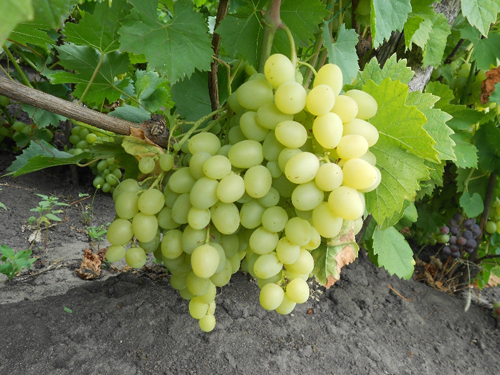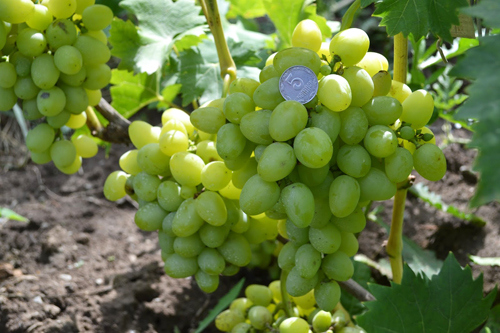Grape variety Nadezhda Aksayskaya
Nadezhda Aksayskaya is one of the fairly new hybrid forms of white table grapes, obtained in the mid-2000s by the famous Don national breeder Vasily Kapelyushny.
As a parental pair, when breeding a hybrid, Vasily Ulyanovich used a magnificent and very popular variety among amateur breeders Mascot with a functionally female type of flower, which was fertilized with pollen of an equally famous Arcadia... As a result of the selection of seedlings, the one that laid the foundation for a new variety was identified. Its morphological properties turned out to be quite similar to those of its father. Because of this, some of the winegrowers suggested that there was no hybridization, and our heroine is the result of ordinary clonal selection, in which planting material from the best plants of the original variety multiplies, and subsequently shrubs with slightly improved characteristics.

Whatever it was, but Nadezhda Aksayskaya, with all her external resemblance to the grapes of Arcadia, demonstrates an earlier ripening period of bunches, somewhat better resistance to frost and resistance to fungal diseases. And this is already enough for her to have the right to life and her own name.
Agrobiological characteristics
Plants of medium vigor. The leaves are large, extended in width with raised edges, mostly five-lobed, weakly dissected. The surface of the leaf blade is reticulate-wrinkled, the color is deep green with light veins. The upper lateral notches are poorly marked or have a V-shape, the lower ones are most often absent. The petiole notch is usually open, vaulted with a flat or pointed bottom, sometimes lyre-shaped. Petioles are long, light green with barely noticeable anthocyanin pigmentation. The teeth along the perimeter of the vine leaf are medium in size, mostly triangular with smooth edges and pointed tops. The flowers of the variety are bisexual, and therefore pollination is quite stable, there are no signs of noticeable pea, shedding of flowers and ovary. The shoots of the current turn ripen well, often over their entire length. The color of the ripe vine changes to light brown in the internodes, and darker in the places where the nodes are located. The autumn color of the foliage of Nadezhda Aksai is yellow.
The bunches grow large and very large in size, their average weight is 800-1100 grams, but there is evidence of outstanding specimens weighing up to 4 kg. The shape of the brushes is broadly conical, the density is moderate to fairly high. The comb is not too long, but thick and strong, pale green in color, sometimes with a pinkish area at the base. The grapes are massive, magnificent in size and shape. The length of oblong or ovoid grapes is 26-28 mm, diameter - 22-23 mm, weight 8-12 grams or more. The color is greenish-white with a light light waxy bloom on the surface. Despite the rather dense structure of the bunch, the berries in it are not subject to deformation and damage to each other. The evenness of the grapes among themselves, as a rule, is not bad. The pulp is dense, juicy-fleshy, has a harmonious, moderately sweet taste, and a pleasant nutmeg aroma that appears after full ripening. Colorless juice, sugar content 16-18 g / 100 cubic meters. cm, and a titratable acidity of 5-6 g / cubic dm. The skin is of medium thickness, quite tough, although easily eaten at the same time. The seeds are small, 2-3 in number, they do not have a significant negative effect on the taste characteristics. General tasting ratings of the variety are on top.

The grown crop of Nadezhda Aksayskaya is used with great success for fresh consumption.Received early and having excellent visual appeal, it finds a wide range of true connoisseurs, and in the market it is in high demand among buyers who perceive it as Arcadia. At the same time, farmers may like it by the fact that it ripens 6-8 days earlier than Arcadia, and therefore can hit the shelves before a massive influx of competitors. The possibilities for implementation are significantly expanded due to the ability to transport the collected bunches. no loss in quality, over long distances, thanks to their excellent transportability. The crop storage suitability of the variety is also quite high, which makes it possible to significantly extend the period of its consumption. In addition to being used directly in food, grapes can be successfully used as raw materials for the production of light and aromatic juices and compotes, as well as delicious preserves and jams. Especially often its processing is practiced in households, where bountiful harvests even from several bushes are unrealistic to be consumed fresh by members of one family.
The beginning of ripening of bunches in the south falls on the first ten days of August. After 110-115 days after budding, you can usually start harvesting. Thanks to such a short growing season, the variety falls into the category of early maturing, and can be successfully cultivated in the middle zone of the country, where the grape harvest will ripen perfectly, even if the harvesting time will shift closer to autumn. The sum of active temperatures required by Nadezhda Aksayskaya during the season is 2300-2400 ° C. A similar level of heat supply is typical for cities such as Kaliningrad, Kaluga or Ryazan, so this particular line can be considered the northern border of its cultivation. When advancing a culture to the north, one should not forget only about the frost resistance of the vine. In this variety, it is even higher (-23 ... -24 ° С), but at the same time it is sufficient for non-covering cultivation only in the south, in traditional regions of viticulture.
The yield of our heroine is very high. According to the author, he managed to achieve an indicator of 35-40 kg of grapes from a bush. However, such records, without fatal overload for the plant, are possible only with the highest level of agricultural technology and on powerful formations with a large supply of old wood. Under normal conditions, a good result will be a productivity of about 15-20 kg, at which the risk of overloading Nadezhda Aksayskaya is minimized. In this regard, the variety requires careful regulation of the load with eyes, shoots and yield, in which the grower must take into account genetically inherent indicators, such as: a high percentage of fruitful shoots, a significant number of inflorescences laid on them, and outstanding large-fruited. If you do not take actions to limit the excessive potential yield of the form, then the likelihood of weakening of the bushes and their death in winter increases significantly.

After the onset of removable maturity, the bunches of grapes can remain for some time on the vine, during which some more sugars will accumulate in the berries, and the characteristic nutmeg aroma will manifest itself with greater force. The variety is moderately prone to cracking of berries, a similar problem manifests itself only with very negative weather factors. Wasps damage sweet and fragrant overripe berries more often, however, there are a significant number of simple, but reliable ways to protect against annoying insects.
Agrotechnical features
The cultivation of Nadezhda Aksayskaya should not cause any particular difficulties for people who are familiar with at least basic knowledge of viticulture technology.As already mentioned, the variety demonstrates many similarities with the paternal form of Arcadia, which means that their agricultural technology should be very similar.
The vineyard is placed in the most warm and sunny areas, which is especially important when growing in the middle lane, outside the zones of traditional viticulture. To do this, they try to select places in the upper part of the southern slopes, and on personal plots, bushes are planted in a wall culture protected from cold winds with the help of various buildings or capital fences. In regions with a sufficient level of SAT, such recommendations are not fundamental, here the variety grows well and manages to ripen even in open flat areas. However, there are also certain generally accepted restrictions. In particular, it is forbidden to plant grapes on the slopes of the northern exposures, in the lowlands of gullies and valleys, where cold air stagnates, as well as on excessively damp soils and places with shallow groundwater.
In areas of soil contamination by root phylloxera, the variety is propagated using grafted seedlings on phylloxera-resistant rootstocks. In the same place where the malicious soil pest has not yet penetrated, the rooting of cuttings of the hybrid itself and their subsequent planting in a permanent place show excellent results. In the latter case, the bushes develop even faster, entering fruiting, usually a year earlier than the grafted plants. The food area for medium-sized grapes, which includes our heroine, should be about 4-5 square meters. meters, depending on local conditions.
Shrub management systems can be different, differing depending on the frost hazard of the climate and, accordingly, the need to shelter the vine for the winter. In the southern regions, with a minimum probability of cold weather stronger than -23 ° C, Nadezhda Aksayskaya can be formed on a high stem, which will have a positive effect on large-fruited and crop quality, due to the large reserves of plastic substances in the volume of perennial wood. However, even with a small movement of the hybrid form of grapes to the north, it will be necessary to use covering forms, such as a multi-arm fan or an inclined cordon.
Plants begin to bear fruit for 2-3 years, after which it becomes necessary for them to be carefully rationed annually by shoots and harvest to avoid overloading, to which the variety has a significant tendency. In spring, fruit arrows are cut into 3-5 buds, due to their high fertility at the base of the shoots, and the bushes themselves are loaded with 30-35 eyes. In the future, weak and sterile shoots of grapes break off, leaving no more than 20-22 fruiting vines, and on each of them, remove extra inflorescences, except for one - the largest.
The ability of the bushes to bear the load, and at the same time the yield indicators, can be significantly improved if the vineyard is regularly watered and fertilized with mineral fertilizers in moderate doses. Maintaining an optimal water regime in the soil will also be useful from the point of view of preventing cracking of the berries of Nadezhda Aksayskaya during ripening.
To combat fungal infections, 2-3 preventive complex treatments of the variety with fungicides in the early stages of the growing season will be required, followed by careful monitoring of the phytosanitary state of grape plantations.








